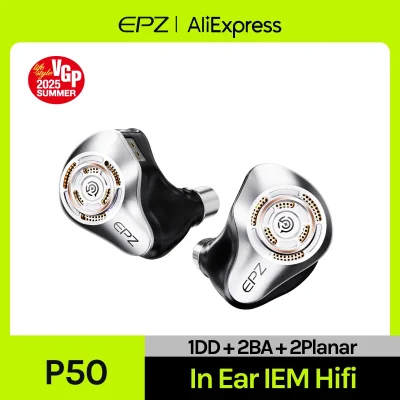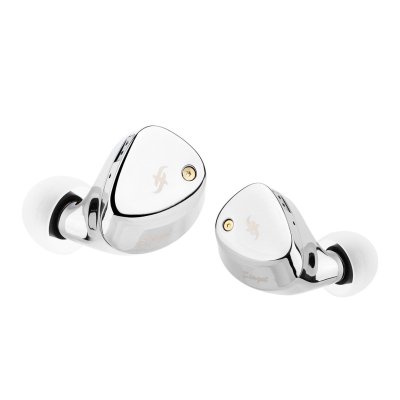EPZ P50 and Simgot ET142 use 1DD+2BA+2Planar and 1Planar+1BC driver setups respectively. EPZ P50 costs $205 while Simgot ET142 costs $220. Simgot ET142 is $15 more expensive. Simgot ET142 holds a slight 0.2-point edge in reviewer scores (7.2 vs 7.4). User ratings place EPZ P50 at 9.5 and Simgot ET142 at 7.3.
Insights
| Metric | EPZ P50 | Simgot ET142 |
|---|---|---|
| Bass | 8.1 | 7.4 |
| Mids | 8.2 | 7.4 |
| Treble | 7.7 | 7.4 |
| Details | 8.3 | 7.4 |
| Soundstage | 7.6 | 7.4 |
| Imaging | 8.4 | 7.4 |
| Dynamics | 6.5 | 7.4 |
| Tonality | 7.3 | 7.5 |
| Technicalities | 7.3 | 8 |
EPZ P50 Aggregated Review Score
Average Reviewer Scores
Average Reviewer Score:
7.2Generally Favorable
Simgot ET142 Aggregated Review Score
Average Reviewer Scores
Average Reviewer Score:
7.4Generally Favorable
Reviews Comparison
EPZ P50 reviewed by Audio Amigo
Youtube Video Summary
EPZ P50 comes as a tribrid at $185 with a surprisingly complete kit: a sturdy leatherette case, modular 3.5/4.4mm terminations, three silicone tip sets, and a cleaning cloth. The resin shells are semi-custom with aluminum faceplates; comfort is generally good but anatomy-dependent, and the stock cable—while well finished—runs on the stiff side. A standout twist is the factory customization option (~$225 total for the “Grindphones” style), which notably doesn’t alter the tuning in any meaningful way. The set is easy to drive, shows minimal change with impedance adapters (a touch warmer/more vocal-forward), and avoids pressure issues thanks to smart internal venting.
Sonically, tuning sits as a controlled, mild V: bass is just north of neutral with pleasing texture and impact, mids stay clean with an engaging female-vocal emphasis, and treble adds airy sparkle without turning tizzy—though insertion depth can trigger length-mode variability for some ears. Technical chops impress at the price: detail retrieval punches up, imaging is precise with good separation, and stage reads average but coherent. Against peers, P50 feels more resolving than Kiwi Ears K4 (trades bigger bass/sparkle for better mid clarity), brighter and more vocal-present than the neutral-leaning Ziigaat Lush, and echoes a Dunu Da Vinci vibe with less bass. Verdict: tremendous value and a terrific pick for vocal-centric libraries—highly recommended to audition first if treble sensitivity or fit quirks are a concern.
Audio Amigo Youtube Channel
Buy EPZ P50 on Aliexpress
Ad
Price: $199
Buy EPZ P50 on Aliexpress
Simgot ET142 reviewed by Audio Amigo
Youtube Video Summary
The Simgot ET142 is a $220 planar–piezo hybrid that arrives like a mini system: full-metal shells, the chunky but well-behaved LC7 modular cable (3.5/4.4 included), a sturdy magnetic case, and four tuning nozzles (titanium stock, gold, short black foam, short red foam). Build is solid and venting prevents pressure issues; finish is a fingerprint magnet and the shell+cable combo is heavy, comfortable for average ears but failing the “tiny ears” test in stock form. Accessory spread is excellent at the price, with multiple tip sets and spare O-rings/foams rounding out a thoughtful package.
Sonically, this is textbook planar bass: clean sub-bass rumble with punchy, textured mid-bass that doesn’t bleed. The midrange stays clear and unmasked, presenting busy mixes with ease, while vocal presence shifts with nozzle choice (short nozzles push fundamentals slightly forward). Treble is where the nozzles matter most: short red = relaxed and smooth; short black = balanced sparkle; titanium/gold = vivid, edging toward “hot” for treble-sensitive listeners. Technical chops impress—crisp microdetail from the PZT without harshness, precise imaging, strong separation, and a notably 3D soundstage. It’s also very easy to drive, playing happily from modest sources.
Think of ET142 as a three-in-one planar: titanium delivers a bright, energetic V-shape (S12/“classic planar” territory), short black dials it to a balanced, less aggressive profile (S12 Pro/2024 vibe), and short red shifts into the modern warm planar lane (akin to S15/S08). Compared with other nozzle-swap sets (e.g., Timeless 2), ET142 offers a wider tuning range up top, trading fine micro-timbre tweaks for genuinely distinct signatures. Caveats: none of the nozzles are truly neutral and the low end stays boosted, so lean-bass seekers should look elsewhere; the weight may be a deal-breaker for small ears. For anyone wanting a versatile planar that can swing from sparkly and fun to warm and relaxing with a quick nozzle swap, this earns a confident “you should buy this” recommendation on value and flexibility alone.
Audio Amigo Youtube Channel
Buy Simgot ET142 on Linsoul
Ad
Price: $219.99
Buy Simgot ET142 on Linsoul
EPZ P50 reviewed by Jays Audio
Youtube Video Summary
The EPZ P50 comes in hot as a new tribrid and a potential $200 neutral benchmark, trading sterile restraint for a more vocal-centric presentation. Versus the MEGA5EST, vocals sit a touch more forward—adding emotional weight and clarity—while the MEGA5EST still edges it on sheer smoothness and EST “air.” Compared to Meteor, the P50 fills in the lower mids, dials back 1–3 kHz glare, and opens the top end a bit; Meteor stays a hair softer up top. The catch is bass: the P50’s DD is competent but not a sub-bass shaker—expect clean rather than authoritative slam.
Against peers, the P50 sounds fuller and more natural than Supermix 4 (which is brighter and more “hi-fi” energetic), and it trades blows with Odyssey: Odyssey brings better bass texture and treble micro-detail, while the P50 delivers superior vocal clarity and a touch more air. It excels at mid-volume listening—Volume S needs more gain to bloom—and outclasses lighter, air-tilted sets like “K4” style tunings when male vocals or body are the priority. Accessory game is strong too: a nicer cable and a genuinely sturdy hard-leather case sweeten the deal. Not the most “unique” flavor and not for bassheads, but as a balanced, clean, vocal-forward option around $200, P50 is an easy recommendation for those chasing neutrality without the vanilla.
Jays Audio Youtube Channel
Simgot ET142 reviewed by Jays Audio
Youtube Video Summary
SIMGOT’s ET142 pairs a planar driver with a PZT, delivering a bright-leaning, lively all-rounder that feels like a more mature, slightly more detailed take on the original S12 tonality. Treble is the surprise: it carries bite and air without the usual planar “sizzle”, landing closer to a well-implemented PZT sheen. Micro-nuance on cymbal work is improved, vocals are open, and technical performance is among the best heard from planars in this bracket. The 2 kHz region can read a touch shy, while overall treble sits above Harman, so expect sparkle and energy rather than warmth.
Volume and fit matter. At mid levels (~60–65 dB) the ET142 sounds engaging and airy; push past ~70–75 dB and the upper energy can turn fatiguing, with forward vocals and sharper highs on busy tracks. Tip choice is critical: treble-boosting tips can be too much, whereas wide-bore, smoother tips (e.g., “Senai Wide”) keep the top end in check. Both included nozzles measure and sound essentially the same—an opportunity missed for a second, tamer tuning. Genre-wise, rock, indie and slower pop benefit from the speed and air; dense electronic can edge bright, while K-/J-pop stays bouncy at moderate volume.
Bass is quick, punchy and clean with tight decay and excellent separation—don’t expect DD-level rumble or lingering reverb, but do expect balance and definition. Versus safer, more relaxed tunings (S8/S15/S12 2024), the ET142 is the more exciting pick; against neutral all-rounders (e.g., “Pilgrim”), it trades smoothness for air and sparkle; compared to sets like “Dusk,” it’s livelier with less treble fizzle but a more forward top end. At around $200, build is excellent (metal shells, braided cable) and the value strong—competing with some $300–$400 options. In short: choose ET142 for a bright, technical, energetic listen; skip it if a laid-back or dark tilt is the goal.
Jays Audio Youtube Channel
EPZ P50 (more reviews)
EPZ P50 reviewed by Super* Review
Youtube Video Summary
EPZ’s P50 feels like a breakout for the brand: a compact, medium-small shell with a vented faceplate that’s marketed as “open-back,” yet isolates like a typical IEM. The unboxing is tidy at this price—carry puck, a real microfiber cloth, and two sets of generic tips—while the modular cable (screw-lock swappable termination) is handy if a bit thin, stiff, and kink-prone; the 2-pin plug sits slightly proud of the socket and the “R” marking is visible on the outside. The long nozzle (~5.5 mm diameter) can push fit depth, so shorter tips (e.g., NF Audio-style) help; once set, stability and comfort are excellent. Overall build looks clean and modern, if a touch editorial compared with EPZ’s other shells.
Sonically, P50 embraces the current tilted diffuse-field “new meta” with a mostly neutral, natural presentation and a later-rising, sub-bass-centric lift that gives bounce rather than mid-bass thump. There’s a hint of extra presence around the 4–5 kHz region that adds macro-contrast—vocals pop with definition and separation is crisp—while upper treble stays safe: cymbals are clean but a bit light in weight. Bass is tight and incisive rather than slammy; micro-texture on vocals is good, though the set favors that big, “stagey” contrast over ultra-fine grain. It’s easily EPZ’s best tuning so far: clear, organized, and engaging without drifting from neutral-ish aims.
Against peers, Kiwi Ears K4 tracks a similar target but sounds lower-contrast and can blur on dense mixes; P50 hits harder on transients, images more cleanly, and keeps busy tracks sorted, while K4 offers a richer midrange with “frothier” treble. Versus the Binary Chopin, Chopin is warmer, fuller, and more mid-bass driven—more “analog” and atmospheric—with deeper perceived space but a bulkier fit; P50 is leaner, clearer, and the least bass-forward of the three. Verdict: a confident 4/5 for delivering a small, comfy fit and a clean, contrasty neutral that competes squarely around $200–$250. If the brief is “neutral with a bit of drama,” this is a strong pick—and a promising sign of where EPZ can go next.
Super* Review original ranking
Super* Review Youtube ChannelEPZ P50 reviewed by Tim Tuned
Tim Tuned Youtube Channel
EPZ P50 reviewed by Jaytiss
Jaytiss Youtube Channel
EPZ P50 reviewed by Kois Archive
Youtube Video Summary
The EPZ P50 arrives as a ~$200 tribrid with a slick presentation: FR graph on the box, a puck-style case, plenty of tips (oddly two identical sets), and a nice microfiber cloth. Build leans premium with a semi-open back and a faceplate that gives “arc reactor” vibes. The custom shell offers a secure fit for most, though very small ears—or anyone sensitive to an inner wing—may need caution. The modular cable (3.5/4.4 mm) is practical yet slightly stiff and retains some memory; isolation is typical of sealed IEMs despite the semi-open styling.
Sonically, the P50 goes for a warm-balanced tuning. Bass quality impresses: bouncy with deep sub-bass reach, prioritizing texture and control over sheer quantity (more thump is possible via an impedance adapter). Mids read natural with a touch of warmth—male vocals shine—while female vocals can feel a bit lean due to a more relaxed upper-mid energy. Treble is smooth, inoffensive, and “planar-clean” without planar timbre, with only a slight wish for more top-end extension.
Technical performance is the star. The micro planars pull out micro-detail unusually well for the price; imaging, separation, and overall resolution feel confidently executed, making guitars pop and busy mixes easy to parse. That clarity translates to gaming, where positional cues and crowded soundscapes (think battle royale chaos) remain intelligible—worthy of a two-controller gaming nod. Overall, the EPZ P50 is a solid contender at this price: balanced tuning with standout detail retrieval and imaging, tempered only by mids that play it a little safe. For listeners unbothered by a gentler upper-mid lift, it’s well worth the money—a two-star recommendation.
Kois Archive Youtube Channel
EPZ P50 reviewed by Gizaudio Axel
EPZ P50 reviewed by Head-Fi.org
EPZ P50 reviewed by Web Search
The EPZ P50 is a tribrid with a 10 mm dynamic driver, two balanced armatures, and two micro planar drivers, implemented in a semi-open back shell and a three-way crossover—an uncommon configuration at this price tier. Listings and spec sheets place impedance at 20 Ω and sensitivity around 106 dB, with interchangeable 3.5/4.4 mm plugs and 0.78 mm 2-pin connectors, positioning it as a flexible daily-carry IEM near the $200 mark.
Subjectively, multiple reviews converge on a neutral-with-bass-boost presentation: sub-bass is tight and weighty when called for, mids stay clear and slightly forward, and treble is extended with extra energy from the planar tweeters. This yields a clean center image and articulate vocals without obvious mid-bass bloom, though the upper-treble emphasis can read “sharper” on some recordings.
Technical performance is competitive for the class: reviewers note solid imaging, above-average separation, and a stage that feels wider than typical sealed IEMs—qualities plausibly aided by the semi-open design and multi-way damping. Trade-offs include reduced isolation versus closed shells and a treble tilt that may fatigue treble-sensitive listeners at high volumes, but overall resolution and micro-detail retrieval punch above its price.
Simgot ET142 (more reviews)
Simgot ET142 reviewed by Z-Reviews
Youtube Video Summary
SIMGOT ET142 comes across as a sleek, chrome-heavy hybrid with a planar + PZT setup, dressed in CNC’d stainless shells and a surprisingly thick premium cable, plus a magnetic case and swappable 4.4/3.5 plug. Two tuning nozzles are included; differences are subtle, but the gold nozzles give a warmer, more relaxed balance versus the blued “airier” set. At a listed ~$220, the build and accessories feel upscale, though that cable is borderline overkill for an IEM.
On power, the ET142’s 14 Ω load behaves better with a more linear solid-state source (e.g., JDS Labs Element) than with tubes; an impedance adapter can tame noise. The tuning reads smooth, non-aggressive, with bass present but not the star; sub-bass “slam” isn’t the focus, yet vocals and staging are clean and pleasing. Treble with the gold nozzles stays polite, while the blued set adds some sparkle without turning harsh.
The special sauce is the imaging: sound feels “inside” and slightly behind the head, creating a quirky but engaging sense of placement that should be excellent for gaming. Overall it fits neatly among planar hybrids at this price—refined, smooth, and easy to enjoy rather than a fireworks show—earning a straightforward recommendation, especially for SIMGOT fans who value comfort, build, and that distinctive spatial presentation over brute-force bass.
Z-Reviews Youtube Channel
Simgot ET142 reviewed by
 Fresh Reviews
Fresh Reviews
Youtube Video Summary
Build & accessories: ET142 arrives with an all-metal chassis, a tidy two-pin cable with interchangeable termination, and swappable nozzles (blue default vs. gold). The blue nozzle proves smoother, as the gold adds extra 2–3 kHz energy that can edge into shout. Ergonomics are compact, vented, and well-finished, though not as feather-light as some resin competitors.
Tuning & technicals: The hybrid architecture (planar plus bone-conduction) projects an expansive, airy stage with clean separation and layering. However, that upper-mid peak can make gunfire and busy mixes feel a bit spicy, leading to a “deer-in-headlights” sensation during chaotic moments. Tonally it’s clear and detailed, but the extra air sometimes pushes nearfield cues slightly forward in the stage instead of delivering immediate urgency.
Gaming performance: Imaging and verticality are solid and footstep cues are intelligible, placing ET142 in a B+ to B range for competitive play. Against a warmer rival with stronger low-end presence, ET142 is less fatiguing than the gold-nozzle setup but still brighter than ideal for Apex/Valorant chaos; the rival’s bass weighting keeps gunfire tamed and localization snappier. Overall, ET142 is good for gaming with strong separation and stage, best for players who value clarity and air over maximum urgency.
Fresh Reviews original ranking
Fresh Reviews Youtube ChannelEPZ P50 Details
Driver Configuration: 1DD+2BA+2Planar
Tuning Type: Neutral with Bass Boost
Price (Msrp): $205
Support our free service! Buying through our affiliate links costs you nothing extra:
Simgot ET142 Details
Driver Configuration: 1Planar+1BC
Tuning Type: V-Shaped
Brand: Simgot Top Simgot IEMs
Price (Msrp): $220
Support our free service! Buying through our affiliate links costs you nothing extra:
EPZ P50 User Review Score
Average User Scores
Average User Score:
Based on 1 user reviews
9.5Exceptional
Simgot ET142 User Review Score
Average User Scores
Average User Score:
Based on 1 user reviews
7.3Generally Favorable
EPZ P50 Gaming Score

Gaming Score & Grade
- The gaming score is prioritizing technical capabilities of the IEM (Separation, Layering, Soundstage) and good value.
Gaming Score
7.3Gaming Grade
A-Simgot ET142 Gaming Score

Gaming Score & Grade
- The gaming score is prioritizing technical capabilities of the IEM (Separation, Layering, Soundstage) and good value.
Gaming Score
8.1Gaming Grade
A+EPZ P50 Scorings
Average Technical & Tuning Grades
Average Tunign Grade
A-- The tonal character feels settled and versatile, with just a few gentle bumps. You can listen for hours without fatigue.
Average Technical Grade
A-- You get a controlled, composed performance, marrying decent clarity with a still-modest sense of space. A safe technical performer for the price bracket.
Simgot ET142 Scorings
Average Technical & Tuning Grades
Average Tunign Grade
A- Tuning feels well executed, keeping a natural flow across the spectrum. Switching genres feels seamless.
Average Technical Grade
A+- A very capable technical display delivers articulate layers and poised imaging. It portrays reverbs and echoes with confidence.
EPZ P50 User Reviews
Share your experience and build your personal ranking list.
You need to be signed in to write your own reviewKillabuck.
Pros
No roughness, Natural timbre, Balanced signature, good note density, Very good consistency, comfortable to use, Good cable, Technically amazing, good accessories, good tips, good transparency, good brightness, tactile bass, not much warmth, nice voices.Cons
None.Simgot ET142 User Reviews
Share your experience and build your personal ranking list.
You need to be signed in to write your own reviewThe Simgot ET142 delivers a smooth and natural sound signature with strong mids but lacks impact in the bass region.
Pros
Clear and detailed mids with good instrument separation; solid build quality and comfortable fit.Cons
Bass can feel a bit light for bassheads; soundstage is average and not very wide.Find your next IEM:
IEM Finder Quiz
newIEM Comparison Tool
newVS






















